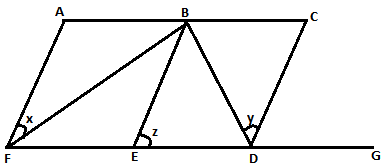12th Grade > Mathematics
SOLUTION OF TRIANGLES MCQs
Total Questions : 15
| Page 2 of 2 pages
Answer: Option A. -> 0
:
A
Let’s construct the lines and angles which constitute the triangle.

We can see once c and B are fixed the least value it should have in order to form a triangle is b = c sin B. In fact, you can form 2 triangles if b > c sin B and B is acute. If B is obtuse by default b > c ⇒ b > c sin B. Therefore no triangle is possible when b < c sin B irrespective of B being acute or obtuse. Answer is 0 triangles are possible.
:
A
Let’s construct the lines and angles which constitute the triangle.

We can see once c and B are fixed the least value it should have in order to form a triangle is b = c sin B. In fact, you can form 2 triangles if b > c sin B and B is acute. If B is obtuse by default b > c ⇒ b > c sin B. Therefore no triangle is possible when b < c sin B irrespective of B being acute or obtuse. Answer is 0 triangles are possible.
Answer: Option B. -> r1=Δs−a,r1=4RsinA2cosB2cosC2
:
B
Relation between Exradius and semiperimeter can be given by, r1=Δs−a where r1 is the radius of the circle opposite the angle A. and it's helpful to remember the identity r1=4RsinA2cosB2cosC2
:
B
Relation between Exradius and semiperimeter can be given by, r1=Δs−a where r1 is the radius of the circle opposite the angle A. and it's helpful to remember the identity r1=4RsinA2cosB2cosC2
Answer: Option C. -> b2−c2
:
C
We know from cosine rule
cosC=a2+b2−C22ab
cosB=a2+c2−b22ac
So we'll use these in the given expression.
a{b(a2+b2−c22ab)−c(a2+c2−b22ac)}
a2+b2−c2−a2−c2+b22
=2(b2−c2)2
=b2−c2
:
C
We know from cosine rule
cosC=a2+b2−C22ab
cosB=a2+c2−b22ac
So we'll use these in the given expression.
a{b(a2+b2−c22ab)−c(a2+c2−b22ac)}
a2+b2−c2−a2−c2+b22
=2(b2−c2)2
=b2−c2
Answer: Option C. -> 3R
:
C
Let the triangle be ABC and the orthocenter be O.
We know that OA = 2RcosA
It is given that triangle is equilateral. So cosA = cos (60°) = 12
And OA = R
Similarly, OB = OC = R
And the sum of them = OA + OB + OC = 3R
:
C
Let the triangle be ABC and the orthocenter be O.
We know that OA = 2RcosA
It is given that triangle is equilateral. So cosA = cos (60°) = 12
And OA = R
Similarly, OB = OC = R
And the sum of them = OA + OB + OC = 3R
Answer: Option B. -> r + 2R = s
:
B
We know, for a Right angled triangle,
R=a2whereA=90∘Also,r=(s−a)tanA2=(s−a)tan45∘=(s−a)=s−2R⇒r+2R=s
:
B
We know, for a Right angled triangle,
R=a2whereA=90∘Also,r=(s−a)tanA2=(s−a)tan45∘=(s−a)=s−2R⇒r+2R=s
















